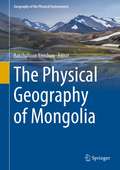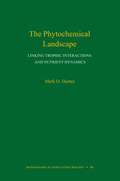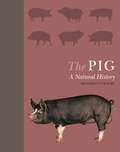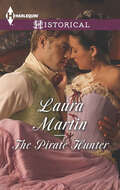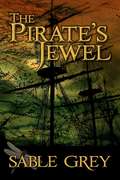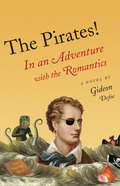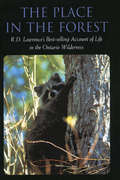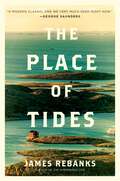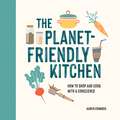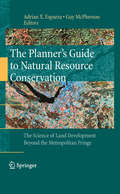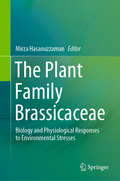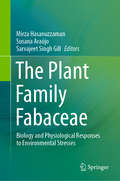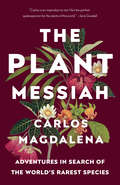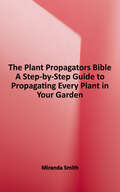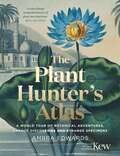- Table View
- List View
The Physical Geography of Mongolia (Geography of the Physical Environment)
by Batchuluun YembuuThis book gives the most detailed and comprehensive physico-geographical overview of the very unique country of Mongolia. The country offers diverse geographical features and natural landscapes combined with a long history. This book offers integrated and systematical research on the geophysical characteristics of Mongolia with an academic orientation. It provides the readers with general knowledge of the physical geography of Mongolia as well as new results of the latest research. The volume consists of 11 chapters, each written by field experts, with contributions from scientific researchers from Mongolia.The topics covered: geological and geomorphological characteristics and processes, landscapes and landforms, climate and climate change, hydrology, glaciers and permafrost, soils, environmental changes, biodiversity and many other aspects of physical geography in Mongolia.The book appeals to researchers and students of geography and related fields and can serve as a guide for field trips to Mongolia or basic literature for research projects.
The Phytochemical Landscape: Linking Trophic Interactions and Nutrient Dynamics
by Mark D. HunterThe dazzling variation in plant chemistry is a primary mediator of trophic interactions, including herbivory, predation, parasitism, and disease. At the same time, such interactions feed back to influence spatial and temporal variation in the chemistry of plants. In this book, Mark Hunter provides a novel approach to linking the trophic interactions of organisms with the cycling of nutrients in ecosystems.Hunter introduces the concept of the "phytochemical landscape"--the shifting spatial and temporal mosaic of plant chemistry that serves as the nexus between trophic interactions and nutrient dynamics. He shows how plant chemistry is both a cause and consequence of trophic interactions, and how it also mediates ecosystem processes such as nutrient cycling. Nutrients and organic molecules in plant tissues affect decomposition rates and the fluxes of elements such as carbon, nitrogen, and phosphorus. The availability of these same nutrients influences the chemistry of cells and tissues that plants produce. In combination, these feedback routes generate pathways by which trophic interactions influence nutrient dynamics and vice versa, mediated through plant chemistry. Hunter provides evidence from terrestrial and aquatic systems for each of these pathways, and describes how a focus on the phytochemical landscape enables us to better understand and manage the ecosystems in which we live.Essential reading for students and researchers alike, this book offers an integrated approach to population-, community-, and ecosystem-level ecological processes.
The Pig: A Natural History
by Richard LutwycheA comprehensive, richly illustrated introduction to the fascinating natural history of the pig, from prehistory to the present At any given time, there are around one billion pigs in the world; that's one for every seven of us. And where would we be without them? Prolific, ubiquitous, smart, adaptable, and providers of high-quality protein, pigs have been our companions since neolithic times, when they obligingly domesticated themselves, coming in from the wild to root around our waste pits. But it's not all about the bacon; today, bred in micro sizes, the resourceful pig has developed a whole new career as a popular pet. And thanks to genome mapping, we now know that the pig shares many common physiological features with humans, spurring the use of pig tissue and organs in medical research and surgery. Beautifully designed and illustrated, The Pig provides a snout-to-tail natural history of this important species, from the prehistoric "hell pig" to today's placid porker, covering the pig's evolution and domestication, anatomy and biology, behavior, role in human life and culture, and breeds. The book also features an engrossing and visually stunning photographic gallery of some thirty popular breeds from around the world, with essential information about each. Filled with surprising facts and insights, The Pig will delight anyone who loves these animals and wants to understand them better. Provides a comprehensive, richly illustrated introduction to the pig's evolution and domestication, anatomy and biology, behavior, role in human life and culture, and breeds. Features infographics, diagrams, and 250 stunning color photographs. Includes a beautiful photographic directory to some 30 popular breeds from around the world, with essential information about each
The Pine Island Paradox: Making Connections in a Disconnected World (The\world As Home Ser.)
by Kathleen Dean MooreCan the love reserved for family and friends be extended to a place? “Luminous essays” on nature and environmental stewardship (Booklist).Named one of the Top Ten Northwest Books of the Year by the OregonianIn this book, acclaimed author Kathleen Dean Moore, a winner of the Sigurd Olson Nature Writing Award for Holdfast, reflects on how deeply the environment is entrenched in the human spirit, despite the notion that nature and humans are somehow separate. Moore’s essays, deeply felt and often funny, make connections in what can appear to be a disconnected world. Written in parable form, her stories of family and friends—of wilderness excursions with her husband and children, camping trips with students, blowing up a dam, her daughter’s arrest for protesting the war in Iraq—affirm an impulse of caring that belies the abstract division of humans from nature, of the sacred from the mundane. Underlying these wonderfully engaging stories is the author’s belief in a new ecological ethic of care, one that expands the idea of community to include the environment, and embraces the land as family.“Stands with the best tradition of nature writing.” —The Oregonian
The Pirate Bride
by Shannon DrakeA Scottish lord discovers his notorious pirate captor is actually a beautiful woman in this historical romance by a New York Times–bestselling author.Those who survive the wrath of Red Robert would never guess the pirate’s secret—Red Robert is a woman, masquerading as a man. Yet though the swift steel of her sword has spread her reputation to the farthest corners of the map, there is only one treasure she seeks—the blood of her lifelong nemesis . . . Blair Colm.Shipwrecked on a desert isle with the handsome Logan Hagarty, she soon rediscovers her femininity in the irresistible captain’s arms. But their paradise skies darken with the appearance of their common enemy. Now the two must summon all their strength and cunning to best the evil Colm, and protect the fierce love that has grown between them.Praise for The Pirate Bride“With wonderful romance, swashbuckling swordsmanship, and winning characters, Drake’s pirate adventure has it all.” —Booklist“The high seas make for great adventure and red-hot passion as a beleaguered ship captain meets his match in the notorious scoundrel Red Robert. . . . Drake constructs a well-drawn plot and provides plenty of sexual tension and romantic encounters as well as exotic scenery.” —Publishers Weekly
The Pirate Hunter
by Laura MartinA forbidden attraction in paradise between a British aristocrat and a pirate’s sister propels this action-packed, Caribbean-set romantic adventure.Shipwrecked off the coast of Barbados, pirate hunter William Greenacre is ready to surrender to the seductive pull of the sea when an angelic figure dives to his rescue. Except this angel is none other than Mia Del Torres—and she’s a wanted woman!To escape imprisonment, Mia must set sail with Will on his mission of revenge and help track down her brother, the formidable Captain Jorge Del Torres. By rights, she should hate Will, yet below deck their passion ignites. But when the hunters become the hunted, will their newly forged connection be enough to save them both?
The Pirate's Jewel
by Sable GreyDuring a time when swashbucklers, privateers, and the Royal Navy battled across the waters, one buccaneer stood out from the rest: raven-haired, green-eyed, and nicknamed the Pirate's Jewel. However, this fiery sea rover answers to no one except herself.Captain Merrick Cole has never met a woman as tough and fearless as Rafferty Jones, nor has he ever had one as sexually matched. Clever, cunning, and dangerously sexy, she's just the kind of woman that can stir a man's blood.Following the orders he is commissioned, Cole captures the woman pirate and sets sail back to London where his commander, John Thornton, wants her delivered and hung. But Rafferty Jones proves she will not go easily, nor will she stifle basic human urges along the way. Cole is prepared to entertain her sexual appetites, but can he remain in control when lust turns to love?
The Pirates of Crocodile Swamp
by Jim ArnoskyA long way from home, Sandy and Jack Casperin escape their abusive father and disappear into Crocodile Swamp, a remote wilderness in the Florida Keys. With nothing but their wits and limited supplies, the boys must learn to fend for themselves as they survive surrounded by snakes, massive crocodiles and a territorial hammerhead shark. But it is only with the help of newfound friends?a local girl their age, and an old sailor (who might be a real pirate!)? that they can truly escape from their tragic past and make a new life for themselves. .
The Pirates!: In an Adventure with the Romantics
by Gideon DefoeIn Gideon Defoe's fifth Pirates! adventure, the dashing Pirate Captain and his intrepid crew encounter perhaps the most swashbuckling poets in history: Lord Byron, Percy Bysshe Shelley, and Shelley's fiancée, Mary Godwin. While visiting the shores of Lake Geneva to restore their spirits and their finances, the Pirate Captain and his crew encounter some surprising fellow adventurers, literary giants of their age: the swaggering Lord Byron, the oddly shifty Percy Shelley, and his smart, quite attractive fiancée, Mary. Together the poets and pirates embark upon a journey that leads from the curiously adventureless Switzerland into the darkest bowels of Oxford, and finally to the forbidding heart of eastern Europe. Amidst haunted castles and early feminism, the Pirate Captain will confront some important questions, namely: What is the secret behind his mysterious belly tattoo? Is "Zombuloid, the corpse-beast" a better name for a monster than "Gorgo: Half-man, half-seaweed?" And, most importantly, what happens when a pirate finally falls in love?
The Pivotal Generation: Why We Have a Moral Responsibility to Slow Climate Change Right Now
by Henry ShueAn eminent philosopher explains why we owe it to future generations to take immediate action on global warmingClimate change is the supreme challenge of our time. Yet despite growing international recognition of the unfolding catastrophe, global carbon emissions continue to rise, hitting an all-time high in 2019. Unless humanity rapidly transitions to renewable energy, it may be too late to stop irreversible ecological damage. In The Pivotal Generation, renowned political philosopher Henry Shue makes an impassioned case for taking immediate, radical action to combat global warming.Shue grounds his argument in a rigorous philosophical analysis of climate change’s moral implications. Unlike previous generations, which didn’t fully understand the danger of burning carbon, we have the knowledge to comprehend and control rising carbon dioxide levels. And unlike future generations, we still have time to mitigate the worst effects of global warming. This generation has the power, and thus the responsibility, to save the planet. Shirking that responsibility only leaves the next generation with an even heavier burden—one they may find impossible to bear.Written in direct, accessible language, The Pivotal Generation approaches the latest scientific research with a singular moral clarity. It’s an urgently needed call to action for anyone concerned about the planet’s future.
The Place in the Forest
by R. D. LawrenceA number of years ago, R.D. Lawrence acquired a patch of Ontario wilderness, soon known as "The Place." Here Lawrence and his wife built a cabin and became immersed in studying the ways of the wild. "The Place" was home to a variety of wildlife, from black bears, wolves, beavers and raccoons through to hawks, snapping turtles and singing mice. Lawrence’s desire to learn, fuelled by his keen observation, led to his writing about and photographing life within his small corner of the forest – the result being a warm, witty account of change and survival in the natural world.
The Place of Many Moods: Udaipur’s Painted Lands and India’s Eighteenth Century
by Dipti KheraA look at the painting traditions of northwestern India in the eighteenth century, and what they reveal about the political and artistic changes of the eraIn the long eighteenth century, artists from Udaipur, a city of lakes in northwestern India, specialized in depicting the vivid sensory ambience of its historic palaces, reservoirs, temples, bazaars, and durbars. As Mughal imperial authority weakened by the late 1600s and the British colonial economy became paramount by the 1830s, new patrons and mobile professionals reshaped urban cultures and artistic genres across early modern India. The Place of Many Moods explores how Udaipur’s artworks—monumental court paintings, royal portraits, Jain letter scrolls, devotional manuscripts, cartographic artifacts, and architectural drawings—represent the period’s major aesthetic, intellectual, and political shifts. Dipti Khera shows that these immersive objects powerfully convey the bhava—the feel, emotion, and mood—of specific places, revealing visions of pleasure, plenitude, and praise. These memorialized moods confront the ways colonial histories have recounted Oriental decadence, shaping how a culture and time are perceived.Illuminating the close relationship between painting and poetry, and the ties among art, architecture, literature, politics, ecology, trade, and religion, Khera examines how Udaipur’s painters aesthetically enticed audiences of courtly connoisseurs, itinerant monks, and mercantile collectives to forge bonds of belonging to real locales in the present and to long for idealized futures. Their pioneering pictures sought to stir such emotions as love, awe, abundance, and wonder, emphasizing the senses, spaces, and sociability essential to the efficacy of objects and expressions of territoriality.The Place of Many Moods uncovers an influential creative legacy of evocative beauty that raises broader questions about how emotions and artifacts operate in constituting history and subjectivity, politics and place.
The Place of Tides
by James Rebanks“The Place of Tides feels like, not only a modern classic, but one we very much need right now.” –George Saunders From perhaps the preeminent nature writer of our time and the acclaimed author of Pastoral Song and The Shepherd’s Life, a magical work of nonfiction in which James Rebanks reflects on a life-changing summer spent on a remote island off the coast of Norway, where his only companion was an old woman who practiced the ancient tradition of collecting eiderdown from birds that nest on this remarkable landscape each year.We are all in need of lights to follow.One afternoon many years ago, James Rebanks met an old woman on a remote Norwegian island. She lived and worked alone on a tiny rocky outcrop, caring for wild Eider ducks and gathering their down. Hers was a centuries-old trade that had once made men and women rich but had long been in decline. Still, somehow, she seemed to be hanging on.Back at home, Rebanks couldn’t stop thinking about the woman on the rocks. She was fierce and otherworldly—and yet strangely familiar. Years passed. Then, one day, he wrote her a letter, asking if he could return. Bring work clothes, she replied, and good boots, and come quickly: her health was failing. And so he travelled to the edge of the Arctic to witness her last season on the island.This is the story of that season. It is the story of a unique and ancient landscape, and of the woman who brought it back to life. It traces the pattern of her work from the rough, isolated toil of bitter winter to the elation of the endless summer light, when the birds leave behind their precious down for gathering, like feathered gold.Slowly, Rebanks begins to understand that this woman and her world are not what he had previously thought. What began as a journey of escape becomes an extraordinary lesson in self-knowledge and forgiveness.
The Planet Remade
by Oliver MortonThe risks of global warming are pressing and potentially vast. The difficulty of doing without fossil fuels is daunting, possibly even insurmountable. So there is an urgent need to rethink our responses to the crisis. To meet that need, a small but increasingly influential group of scientists is exploring proposals for planned human intervention in the climate system: a stratospheric veil against the sun, the cultivation of photosynthetic plankton, fleets of unmanned ships seeding the clouds. These are the technologies of geoengineering--and as Oliver Morton argues in this visionary book, it would be as irresponsible to ignore them as it would be foolish to see them as a simple solution to the problem. The Planet Remade explores the history, politics, and cutting-edge science of geoengineering. Morton weighs both the promise and perils of these controversial strategies and puts them in the broadest possible context. The past century's changes to the planet--to the clouds and the soils, to the winds and the seas, to the great cycles of nitrogen and carbon--have been far more profound than most of us realize. Appreciating those changes clarifies not just the scale of what needs to be done about global warming, but also our relationship to nature. Climate change is not just one of the twenty-first century's defining political challenges. Morton untangles the implications of our failure to meet the challenge of climate change and reintroduces the hope that we might. He addresses the deep fear that comes with seeing humans as a force of nature, and asks what it might mean--and what it might require of us--to try and use that force for good.
The Planet-Friendly Kitchen: How to Shop and Cook With a Conscience
by Karen EdwardsWe all have the power to make a differenceWe know our planet’s resources are stretched to the limits. We know that without significant changes to our diets and shopping habits, nature will continue to suffer. But sometimes it feels like we’re bombarded with mixed messages, and it can be hard to work out which foods are truly eco-friendly. This book sets out the facts in a clear and straightforward way, helping you to make informed choices about environmentally conscious ways to shop, the products to avoid, the best foods to buy, and sustainable ways to prepare them.With over 30 delicious recipes that you, and the earth, will love, The Planet-Friendly Kitchen contains all the tips and advice you need to start making small changes that have big impacts. The choices we make can help create a kinder way of feeding the world, and will preserve our beautiful planet for many generations to come.
The Planet-Friendly Kitchen: How to Shop and Cook With a Conscience
by Karen EdwardsWe all have the power to make a differenceWe know our planet’s resources are stretched to the limits. We know that without significant changes to our diets and shopping habits, nature will continue to suffer. But sometimes it feels like we’re bombarded with mixed messages, and it can be hard to work out which foods are truly eco-friendly. This book sets out the facts in a clear and straightforward way, helping you to make informed choices about environmentally conscious ways to shop, the products to avoid, the best foods to buy, and sustainable ways to prepare them.With over 30 delicious recipes that you, and the earth, will love, The Planet-Friendly Kitchen contains all the tips and advice you need to start making small changes that have big impacts. The choices we make can help create a kinder way of feeding the world, and will preserve our beautiful planet for many generations to come.
The Planets
by Dava SobelA rich exploration of our solar system--what we know, what we wonder, what we believe.
The Planner’s Guide to Natural Resource Conservation:
by Adrian X. Esparza Guy McphersonMuch of the country's recent population growth is situated in exurban areas. By many accounts exurbanization has become the dominant pattern of land development in the country and there is no indication it will slow in the foreseeable future (Theobald 2005; Brown et al. 2005; Glennon and Kretser 2005). By definition, exurban development takes place beyond the metropolitan fringe, often in rural and remote areas. The development of new exurban communities is a growing trend, especially in the West. In this case, developers and homebuilders seek large tracts of land, up to thousands of acres, in rural areas (typically within 50 miles of a large city) where they plan entire communities consisting of commercial, retail and residential land uses. Recreational amenities such as golf courses and hiking/biking trails are often included in these master-planned developments. Our philosophy is reflected in the book's two objectives. First, we seek to document the extent and impacts of exurban development across the country. At issue is demonstrating why planners and the public-at-large should be concerned about exurbanization. We will demonstrate that even though exurbanization favors amenity rich regions, it affects all areas of the country through the loss of agricultural and grazing lands, impacts to watersheds and land modification. A summary of environmental impacts is presented, including the loss of wildlands and agricultural productivity, land modification, soil erosion, impacts to terrestrial hydrologic systems, the loss of biodiversity, nonnative and endangered species and other topics. Our second aim is to provide readers from diverse (nonscientific) backgrounds with a working knowledge of how and why exurbanization impacts environmental systems. This is accomplished by working closely to ensure contributors follow a specific outline for each chapter. First, contributors will spell out fundamental concepts, principles and processes that apply to their area of expertise (e.g., riparian areas). Contributors will move beyond a cursory understanding of ecological processes without overwhelming readers with the dense material found typically in specialized texts. For this reason, visuals and other support materials will be integral to each chapter. We have chosen contributors carefully based on their record as research scientists and acumen as educators. Second, once the mechanics have been laid out, authors will explain how and why land development in nearby areas influences ecosystems. Issues of interdependency, modification and adaptation, spatial scale and varying time horizons will be featured. Third, contributors will weigh in on the pros and cons of various land-development schemes. Fourth, authors will share their thinking on the merits of conservation devices such as wildlife corridors, open-space requirements and watershed management districts. Finally, each chapter will conclude by identifying pitfalls to avoid and highlighting "best practices" that will mitigate environmental problems or avoid them altogether. In sum, after completing each chapter, readers should have a firm grasp of relevant concepts and processes, an understanding of current research and know how to apply science to land-use decisions.
The Plant Family Brassicaceae: Biology and Physiological Responses to Environmental Stresses
by Mirza HasanuzzamanThis book provides all aspects of the physiology, stress responses and tolerance to abiotic stresses of the Brassicaceae plants. Different plant families have been providing food, fodder, fuel, medicine and other basic needs for the human and animal since the ancient time. Among the plant families, Brassicaceae has special importance for their agri-horticultural importance and multifarious uses apart from the basic needs. Interest understanding the response of Brassicaceae plants toward abiotic stresses is growing considering the economic importance and the special adaptive mechanisms. The knowledge needs to be translated into improved elite lines that can contribute to achieve food security. The physiological and molecular mechanisms acting on Brassicaceae introduced in this book are useful to students and researchers working on biology, physiology, environmental interactions and biotechnology of Brassicaceae plants.
The Plant Family Fabaceae: Biology and Physiological Responses to Environmental Stresses
by Sarvajeet Singh Gill Mirza Hasanuzzaman Susana AraújoThis book comprehensively introduces all aspects of the physiology, stress responses and tolerance to abiotic stresses of the Fabaceae plants. Different plant families have been providing food, fodder, fuel, medicine and other basic needs for the human and animal since the ancient time. Among the plant families Fabaceae have special importance for their agri-horticultural importance and multifarious uses apart from the basic needs. Interest in the response of Fabaceae plants toward abiotic stresses is growing considering the economic importance and the special adaptive mechanisms. Recent advances and developments in molecular and biotechnological tools has contributed to ease and wider this mission. This book provides up-to-date findings that will be of greater use for the students and researchers, particularly Plant Physiologists, Environmental Scientists, Biotechnologists, Botanists, Food Scientists and Agronomists, to get the information on the recent advances on this plant family in regard to physiology and stress tolerance.
The Plant Messiah: Adventures in Search of the World's Rarest Species
by Carlos MagdalenaAn impassioned memoir of saving extraordinary plants on the brink of extinction, by a scientist who has been called a "codebreaker" (Telegraph) and "an inspiration" (Jane Goodall)Carlos Magdalena is not your average horticulturist. He's a man on a mission to save the world's most endangered plants. First captivated by the flora of his native Spain, he has travelled to the remotest parts of the globe in search of exotic species. Renowned for his pioneering work, he has committed his life to protecting plants from man-made ecological destruction and thieves hunting for wealthy collectors.In The Plant Messiah, Magdalena takes readers from the Amazon to the jungles of Mauritius to deep within the Australian Outback in search of the rare and the vulnerable. Back in the lab, we watch as he develops groundbreaking, left-field techniques for rescuing species from extinction, encouraging them to propagate and thrive once again. Along the way, he offers moving, heartfelt stories about the secrets contained within these incredible organisms. Passionate and absorbing, The Plant Messiah is a tribute to the diversity of life on our planet, and the importance of preserving it.*Featuring 16 pages of color photos*
The Plant Propagator's Bible: A Step-by-Step Guide to Propagating Every Plant in Your Garden
by Miranda SmithThe Plant Propagator's Bible offers all you need to know to propagate new plants from existing ones.
The Plant-Hunter's Atlas: A World Tour of Botanical Adventures, Chance Discoveries and Strange Specimens
by Ambra Edwards'A refreshingly insightful history of plant introductions.' - Roy Lancaster Travel the world with extraordinary tales of the botanical discoveries that have shaped empires, built (and destroyed) economies, revolutionised medicine and advanced our understanding of science.Circling the globe from Australia's Botany Bay to the Tibetan plateau, from the deserts of Southern Africa to the jungles of Brazil, this book presents an incredible cast of characters - dedicated researchers and reckless adventurers, physicians, lovers and thieves. Meet dauntless Scots explorer David Douglas and visionary Prussian thinker Alexander von Humboldt, the 'Green Samurai' Mikinori Ogisu and the intrepid 17th century entomologist Maria Sibylla Merian - the first woman known to have made a living from science.Beautifully illustrated with over 100 botanical artworks from the archives of the Royal Botanic Gardens, Kew, this absorbing book tells the stories of how plants have travelled across the world - from the missions of the Pharaohs right up to 21st century seed-banks and the many new and endangered species being named every year.***THE ROYAL BOTANIC GARDENS, KEW is a world-famous research organisation and a major international visitor attraction. It harnesses the power of its science, the rich diversity of its gardens and collections to unearth why plants and fungi matter to everyone. Its aspiration is to end the extinction crisis and help create a world where nature and biodiversity are protected, valued and managed sustainably.
The Plant-Hunter's Atlas: A World Tour of Botanical Adventures, Chance Discoveries and Strange Specimens
by Ambra Edwards'A refreshingly insightful history of plant introductions.' - Roy Lancaster Travel the world with extraordinary tales of the botanical discoveries that have shaped empires, built (and destroyed) economies, revolutionised medicine and advanced our understanding of science.Circling the globe from Australia's Botany Bay to the Tibetan plateau, from the deserts of Southern Africa to the jungles of Brazil, this book presents an incredible cast of characters - dedicated researchers and reckless adventurers, physicians, lovers and thieves. Meet dauntless Scots explorer David Douglas and visionary Prussian thinker Alexander von Humboldt, the 'Green Samurai' Mikinori Ogisu and the intrepid 17th century entomologist Maria Sibylla Merian - the first woman known to have made a living from science.Beautifully illustrated with over 100 botanical artworks from the archives of the Royal Botanic Gardens, Kew, this absorbing book tells the stories of how plants have travelled across the world - from the missions of the Pharaohs right up to 21st century seed-banks and the many new and endangered species being named every year.***THE ROYAL BOTANIC GARDENS, KEW is a world-famous research organisation and a major international visitor attraction. It harnesses the power of its science, the rich diversity of its gardens and collections to unearth why plants and fungi matter to everyone. Its aspiration is to end the extinction crisis and help create a world where nature and biodiversity are protected, valued and managed sustainably.
The Plant-Hunter's Atlas: A World Tour of Botanical Adventures, Chance Discoveries and Strange Specimens
by Ambra EdwardsThe Plant Hunter's Atlas is a lavishly illustrated volume telling some of the most extraordinary tales of horticultural discovery and exploring the characters behind the stories. Taking in the world's inhabited continents and spanning the centuries, the stories range from tales of derring-do in the age of discovery to modern-day botanists working at the cutting-edge of science. The text explores how plant hunters have been inspired by everything from scientific curiosity to economic greed, and their own ingrained sense of adventure. Each entry is illustrated with botanical artwork from the Royal Botanical Gardens, Kew's unrivalled collection of historical illustrations. Among the plant hunters included are: Sir Joseph Banks, Charles Darwin, David Douglas, Reginald Farrer, George Forrest, Robert Fortune, Tadeáš Haenke, Tom Hart Dyke, Alexander von Humboldt, the Lobb brothers, John Sibthorp and Ernest Henry Wilson.(P)2021 Quercus Editions Limited
